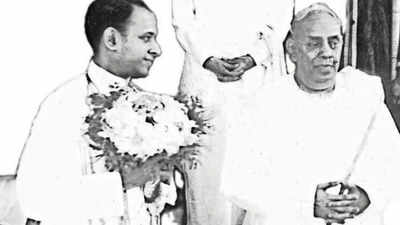- News
- City News
- kochi News
- 75 years of Kochi-Travancore merger: A far-sighted king who gave up his kingdom for an almanac
Trending
75 years of Kochi-Travancore merger: A far-sighted king who gave up his kingdom for an almanac
Discover the rich history of the State of Travancore-Cochin through the merging pact, highlighting the preservation of heritage sites like Koonoor Elk Hill Palace and the legacy of the Kochi royal family.

Kochi king Rama Varma Pareekshith Thampuran (right) receiving Travancore king Chithira Thirunal Bala Rama Varma at Hill Palace in 1949
Rama Varma Pareekshith Thampuran and Chithira Thirunal Bala Rama Varma, the kings of Kochi and Travancore respectively, signed the document merging the two big and powerful provinces. The occasion, in the durbar hall of Hill Palace, the headquarters of Kochi kingdom, bore witness not just to some serious discussions involving India govt's official spokesperson V P Menon among others, but act of the Kochi king turning down even the Uparajapramukh title offered to him.
‘Pareekshith Thampuran was the role model of Kochi kings’
Before the official beginning of the discussion, Pareekshith Thampuran remained with folded hands and closed eyes for a moment. He was seeking blessings and sanction for the merger from their family deity Sree Poornathrayeeshan,” Mrinalini Thampuran, 98, the present Valiyamma Thampuran (seniormost female member) of Kochi royal family, recollected what the late Elamana Hari, the then Hill Palace superintendent and a close associate of Pareekshith Thampuran, had told her about the proceedings on that day.
Menon had held a round of discussions and returned to Delhi. Sardar Vallabhai Patel, the master brain behind integrated India, himself visited the Hill Palace for the final round of discussions with the Kochi Maharaja in the last week of June, 1949. Patel concluded the talks with the offer that after integration, Travancore King Sree Chithira Thirunal Bala Rama Varma would be titled as Raja Pramukh and Rama Varma Pareekshith Thampuran as Uparajapramukh.
Thampuran turned down the title and said Valiya Thampuran, as the senior most members of the kingdom are known, would suffice.
In fact, the seeds of integration were sown by his predecessor Kerala Varma, popularly known as Aikya Kerala Thampuran.
He organised a conclave at Thrissur Thekkinkadu Maidan on April 11, 1947, to discuss the merger of Travancore and Cochin, even before India was declared independent, recalled Mrinalini, who was in her early 20s back then. Soon after the official declaration on the formation of State of Travancore-Cochin, Pareekshith Thampuran started formal talks with his sub- ordinates like Kochi state chief minister Ikkanda Warier and other ministers Sahodaran Ayyappan, C A Ouseph and Panampilly Govinda Menon.
T K Narayana Pillai from Paravoor became the first chief minister of Thirukochi state.
“Pareekshith Thampuran was the role model of Kochi kings with an ascetic mind. Unlike many north Indian provinces, what he demanded in return for handing over the governance surprised the representatives of Jawaharlal Nehru, Patel and Menon,” Mrinalini recalled about her grand uncle.
“Then Travancore diwan C P Ramaswami Iyer played apivotal role in retaining many rights of the Travancore royal family. Absence of such an adviser cost the Kochi royal family,” said Mrinalini.
V P Menon, during a private talk with politician V K Krishna Menon, expressed his inability to give the deserving rights for Kochi kings because Pareekshith Thampuran didn’t ask anything in return for handing over power, she said.
“What the Kochi kings could retain was the Hill Palace complex, Palace No.16, the official residence of Kochi kings, and the Koonoor Elk Hill Palace. The Kochi royal family gave Hill Palace voluntarily to the state govt, which is now functioning as an archaeological museum.
What remains now as memories of royal reign are Valiyamma Thampuran Kovilakam, Ettu Kettu (with two internal courtyards) and Kalikotta Palace, designed by Shakthan Thampuran. Besides these general assets of the Kochi royal family, a handful of individual palaces like Mangalalayam Palace, Lakshmithoppu Palace, Edooppu Palace and Raj Bhavan Palace could also withstand the test of time. Also, the great king’s largesse.
End of Article
FOLLOW US ON SOCIAL MEDIA










